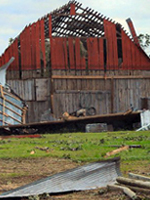
Franzoy, Alexander AlfredAboutUse of German and Italian prisoners of war as farm laborers during World War II. Use of other types of farm labor before and after World War II. Description of the Franzoy farm when consultant's father bought the land in 1918.
Abstract
Tape 1, Side A
The consultant describes the wet and sandy land that his father bought in 1918 along the Rio Grande near Salem. The family improved it, added acreage, and by World War II were growing tomatoes, onions and cotton. Franzoy said he used "the Spanish people" from the Salem area until those men left for military service. (Migrant workers also were used before the war, Franzoy says later in the interview.) Franzoy and other area farmers helped to prepare a site in Hatch as a prisoner of war camp. Both German and Italian prisoners worked on Franzoy's farm, picking tomatoes and cotton and topping onions. Transportation between the farm and the camp was provided by Mr. Franzoy. The most regular workers at the farm were the same group of sixteen Germans; "good people" who brought Mr. Franzoy's children candy bars, which were scarce during the war. The Franzoys would give their work crews, whether German or Italian, a dinner at Thanksgiving and other holidays. Franzoy describes punishment for prisoners of war who would "get out of order" at the farm. Those prisoners were given two to three days in an enclosed structure at the Hatch camp; a "tank" normally used for grain storage, with a door and no toilet facilities. After the war Franzoy tried to arrange for one of the German workers to stay in the United States and work on the farm. The German wanted to remain, the consultant said, but was not allowed to do so. Post-war workers at the farm included Braceros, Mexican nationals who were allowed to live and work in the United States under an agreement between the United States and Mexico. When the Bracero Program ended, "Mexico labor" still was used. Franzoy said the labor market now is "bad" and predicted that machinery would replace many more workers. |

